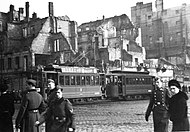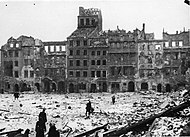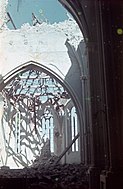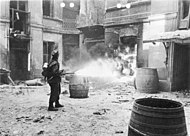사용자:Castellaa/연습장1
Destruction of Warsaw[편집]
바르샤바 파괴[편집]
이 문서의 lead은(는) 출처가 분명하지 않습니다. |
바르샤바 파괴는 1944년 폴란드 저항군의 바르샤바 봉기 이후, 1944년 후반 나치 독일이 도시를 실질적으로 파괴한 것을 말한다. 봉기는 독일 지도부를 격분시켰다. 이에 지도부는 도시를 파괴함으로써 보복했다.
독일의 도시 파괴는 오랫동안 계획되어 있었다. 나치는 게네랄플란 오스트에 따른 중앙유럽 독일화 계획의 일환으로 대규모의 파괴와 재건을 위하여 바르샤바를 선택했다. 그러나 1944년 말, 패망은 분명했고 독일은 동부 식민지화 계획을 포기하게 되었다. 그러므로 바르샤바 파괴는 어떠한 군사적, 식민적 목적에도 도움이 되지 않았고 오로지 보복으로만 수행되었다.
독일군은 도시를 파괴하기 위해 전례 없는 노력을 기울여 박물관, 미술관, 극장, 교회, 공원, 성채, 궁전과 같은 역사적인 건물을 포함한 바르샤바의 건물의 80-90%를 파괴했다. 독일군은 의도적으로 바르샤바의 문화 유산을 파괴하거나 불태우고 훔쳤다. 전쟁 이후, 전쟁 전의 계획과 역사적 문서에 따라 도시를 복원하기 위한 대규모의 작업이 이루어졌다.

The city must completely disappear from the surface of the earth and serve only as a transport station for the Wehrmacht. No stone can remain standing. Every building must be razed to its foundation.
전쟁 전의 파괴 계획[편집]
1939년 6월 20일 아돌프 히틀러가 뷔르츠부르크 암 마인의 건설국을 방문했을 때, 그는 미래의 독일 마을인 '새로운 독일 도시 바르샤우(Neue deutsche Stadt Warschau) 프로젝트'를 알아차렸다. 파브스트 계획에 따르면 바르샤바는 13만 인구의 독일 지방 도시가 될 예정이었다. 제3제국의 계획자들은 히틀러의 관저로 사용될 왕성(王城)을 비롯한 몇몇 랜드마크가 보존되는, 역사적인 "게르만" 코어의 윤곽을 담은 정밀한 초안을 작성했다. 15개의 도면과 미니어처로 이루어진 이 계획은 독일 육군 건축가 프리드리히 파브스트의 이름이 붙여졌다. 그는 물리적, 건축적 흔적을 없애버려 국민의 사기와 문화를 파괴하겠다는 개념을 다듬었다. 바르샤바를 파괴하고 그 터에 지어질 독일 신도시의 실제적인 디자인은 휴버트 그로스가 했다.[3][4] 바르샤바 봉기 실패의 여파는 히틀러가 전쟁 전의 구상을 깨닫는 기회를 제공했다.[5]

바르샤바 폭동의 여파[편집]
민간인 추방[편집]


The Warsaw Uprising was launched by the Polish Home Army on August 1, 1944, as part of Operation Tempest. In response, under orders from Heinrich Himmler, Warsaw was kept under ceaseless barrage by Nazi artillery and air power for sixty-three days and nights by Erich von dem Bach-Zelewski.
In 1944, a large transit camp (Durchgangslager) was constructed in Pruszków's Train Repair Shops (Zakłady Naprawcze Taboru Kolejowego) to house the evacuees expelled from Warsaw. In the course of the Warsaw Uprising and its suppression, the Germans deported approximately 550,000 of the city's residents and approximately 100,000 civilians from its outskirts, sending them to Dulag 121 in Pruszków. The security police and the SS segregated the deportees and decided their fate. Approximately 650,000 people passed through the Pruszków camp in August, September, and October. Approximately 55,000 were sent to concentration camps, including 13,000 to Auschwitz. They included people from a variety of social classes, occupations, physical conditions, and ages. Evacuees ranged from infants only a few weeks old to the extremely elderly. In a few cases, these were also people of different ethnic backgrounds, including Jews living on "Aryan papers".[6]
약탈과 건물 파괴[편집]


After the remaining population had been expelled, the Germans began the destruction of the remnants of the city.[9] Special groups of German combat engineers were dispatched throughout the city in order to burn (Brandkommandos) and demolish (Sprengkommandos) the remaining buildings. According to German plans, after the war Warsaw was to be turned into nothing more than a military transit station.[10]
By January 1945, between 85% and 90% of the buildings had been completely destroyed; this includes up to 10% as a result of the September 1939 campaign and following combat, up to 15% during the earlier Warsaw Ghetto Uprising, 25% during the Uprising, and 40% due to systematic German demolition of city after the uprising.[9]틀:Failed verification



Material losses were estimated at 10,455 buildings, 923 historical buildings (94%), 25 churches, 14 libraries including the National Library, 81 primary schools, 64 high schools, the University of Warsaw, the Warsaw University of Technology, and most of the city's historical monuments.[9] Almost a million inhabitants lost all of their possessions.[9] The exact losses of private and public property, including pieces of art, other cultural artifacts and scientific artifacts, is unknown but must be considered substantial since Warsaw and her inhabitants were the richest and wealthiest Poles in pre-war Poland. In 2004, the President of Warsaw, Lech Kaczyński (later President of Poland), established a historical commission to estimate losses to public property alone that were inflicted on the city by German authorities. The commission estimated the losses to be at least $31.5 billion.[12] Those estimates were later raised to $45 billion and in 2005, to $54.6 billion (all equated to 2004 dollars). The official estimates don't include immense losses of private property, which are of unknown value since almost all of the pre-war documents (such as insurance values of private collections) have also been destroyed, but are considered between double and triple the official estimates (which are based on documented losses only[13] while for example, the National Library's list of pre-war property lost estimated to be 1% of its collection since Germans destroyed all archives too).
도서관 방화[편집]


During the German suppression of the Warsaw Uprising of 1944, around 70 to 80% of libraries were carefully burned by the Brandkommandos (burning detachments), whose mission was to burn Warsaw.[14] In October 1944 the Załuski Library, the oldest public library in Poland and one of the oldest and most important libraries in Europe (established in 1747), was burned down.[15] Out of about 400,000 printed items, maps and manuscripts, only some 1,800 manuscripts and 30,000 printed materials survived.[15]
In the last phase of the Warsaw Uprising and after its collapse, in September and October 1944, the three major private libraries in Warsaw (Krasiński Library, Przeździecki Library and the Libraty of Zamoyski Family Entail), including collections of priceless value to Polish culture, ceased to exist.[16] Those libraries had already suffered in September 1939, when they were bombed and burned.[16]
An important collection of books belonging to the Krasiński Library, created in 1844, was largely destroyed in 1944.[17] The collection originally consisted of 250,000 items.[17] During the Uprising, on September 5, 1944, the library's warehouses were shelled by German artillery and burned almost completely.[17] Some of the books were preserved, thrown through windows by the library's staff.[17] The surviving collection was later deliberately burned by the Germans in October 1944 after collapse of the Uprising.[17] About 26,000 manuscripts, 2,500 incunables, 80,000 early printed books, 100,000 drawings and prints, 50,000 note and theater manuscripts, and a large collection of maps and atlases were lost.[17] The Przeździecki Estate Library in 6 Foksal Street included 60,000 volumes and 500 manuscripts, a rich archive containing 800 parchment and paper documents, and a cartographic collection consisting of 350 maps, atlases and plans.[16] In addition to 10,000 prints and drawings, there was an extensive art gallery (Portrait of Casimir Jagiellon from the 15th century, Portrait of John III Sobieski from the Schleissheim Palace, the House altar of Sophia Jagiellon, 1456), valuable collection of miniatures and decorative art: textiles, porcelain, faience, glass, gold objects, military, etc.[16] It burned down on September 25, 1939 as a result of severe aerial bombardment by the Germans (incendiary bombing).[16] The surviving items sheltered in the neighbouring tenement house at Szczygla Street were burned in October 1944.[16] The last of above mentioned libraries, the Library of the Zamoyski Family Entail, acquired collections of 70,000 works (97,000 volumes), more than 2,000 manuscripts, 624 parchment diplomas, several thousand manuscripts, a collection of engravings, coins and 315 maps and atlases.[16] Library collections also gathered numerous collections of art: a rich collection of militaria, miniatures, porcelain, faience and glass, natural collections, research tools etc., gathered mostly during the existence of the Zamoyski Academy.[16] In 1939, about 50,000 items (about 30%) were destroyed in bombing.[16] On September 8, 1944, the Germans set fire to both the Zamoyski Palace (Blue Palace) and the library building.[16]
The Central Military Library, containing 350,000 books on the history of Poland, was destroyed, including the Library of Polish Museum in Rapperswil deposited there for safekeeping. The collection of the Rapperswil Library was transported to Poland in 1927.[18] The library and the museum were founded in Rapperswil, Switzerland, in 1870 as "a refuge for [Poland's] historic memorabilia dishonored and plundered in the [occupied Polish] homeland" and for the promotion of Polish interests.[19] The greater part of library's collections, originally 20,000 engravings, 92,000 books and 27,000 manuscripts, were deliberately destroyed by the Germans in 1944.[18]
Unlike earlier Nazi book burnings where specific books were deliberately targeted, the burning of those libraries was part of the general burning of a large part of the city of Warsaw.[20] This resulted in the disappearance of many valuable old books and scrolls among about sixteen million volumes from National Library, museums and palaces burnt indiscriminately by Germans in Poland during World War II.[14]
파괴의 범위[편집]
| 종류 | 파괴 추정치 |
|---|---|
| 도로와 철도 교량 | 100% |
| 극장과 영화관 | 95% |
| 산업 시설 | 90% |
| 의료 시설 | 90% |
| 역사적 기념물 | 90% |
| 트램 기반 시설 | 85% |
| 트램 차량 | 75% |
| 주택 | 72% |
| 교육 기관 | 70% |
| 공원과 정원의 수목 | 60% |
| 전기 시설 | 50% |
| 가스관 | 46% |
| 상수도 | 30% |
| 도로 포장 | 30% |
갤러리[편집]
-
Warsaw during World War II: destroyed townhouses between Zielna (top) and Marszałkowska streets (bottom). In bottom right corner building Marszałkowska 156 on the corner with Królewskia street, also visible Bloch Palace at Marszałkowska 154. September 1939
-
Intersection of Marszałkowska Street and Aleje Jerozolimskie Street in Warsaw during German occupation. Visible tramway #3 with a billboard "Kamea woda kwiatowa". Behind it ruins of destroyed in 1939 townhouse at Marszałkowska 98/al. Jerozolimskie 33 streets.
-
Prudential Building, hit by a 2-ton mortar shell
-
Warsaw Old Town marketplace, 1945
-
Royal Castle reduced to rubble
-
Marszałkowska Street in flames
-
German soldiers in front of a burning Ursus factory
-
St. Mary's Church, destroyed in 1944.
-
Statue of Jesus Christ from the Holy Cross Church
-
Mirów Halls in flames
-
Sigismund's Column demolished by German tank shell
-
A German soldier sets fire to a building
-
Aerial photograph of the destroyed Warsaw Ghetto
-
Polish soldier's grave before ruins on Wyjazd Street
-
Parade of the First Polish Army on Marszałkowska Street
-
Royal Castle near the Vistula River (1948)
바르샤바 재건[편집]

Warsaw was rebuilt by the Polish people between the 1950s and 1970s. The Palace of Culture and Science (completed in 1955) was a "gift" from the Soviet Union. Some landmarks were reconstructed as late as the 1980s. While the Old Town has been thoroughly reconstructed, the New Town has been only partially restored to its former state.[22]
같이 보기[편집]
- Chronicles of Terror
- Destruction of Kalisz
- List of libraries damaged during World War II
- List of Polish cities damaged in World War II
- Nero Decree
각주[편집]
- ↑ Source: (Polish) Adolf Ciborowski, Warszawa – o zniszczeniu i odbudowie miasta, Warsaw, Interpress Publishers, 1969, p. 57.
- ↑ Krystyna Wituska, Irene Tomaszewski, Inside a Gestapo Prison: The Letters of Krystyna Wituska, 1942–1944, Wayne State University Press, 2006, ISBN 0-8143-3294-3, Google Print, p.xxii
- ↑ Getter, Marek (August–September 2004). “Straty ludzkie i materialne w Powstaniu Warszawskim” (PDF). 《Biuletyn IPN》 8–9: 71. December 17, 2013에 원본 문서 (PDF)에서 보존된 문서.
- ↑ Mix, Andreas (2009년 9월 26일). “Eine Germanisierungsphantasie”. 《Berliner Zeitung》. 2013년 12월 16일에 확인함.
- ↑ Niels Gutschow, Barbarta Klain: Vernichtung und Utopie. Stadtplanung Warschau 1939 – 1945, Hamburg 1994, ISBN 3-88506-223-2
- ↑ Księga Pamięci, Transporty Polaków z Warszawy do KL Auschwitz 1940–1944 (Memorial Book: Transports of Poles from Warsaw to Auschwitz Concentration Camp 1940–1944)
- ↑ “Warsaw Uprising of 1944”. 《www.warsawuprising.com》. 2008년 7월 14일에 확인함.
- ↑ Axis Forum
- ↑ 가 나 다 라 Warsaw Uprising: FAQ
- ↑ Peter K. Gessner, "For over two months..." 보관됨 12월 3, 2005 - 웨이백 머신
- ↑ Source: (Polish): Adolf Ciborowski: O zniszczeniu i odbudowie miasta (A City Destroyed and Rebuilt), Warszawa 1969, Poland: "Interpress" Publishers, p.63
- ↑ “Warszawa szacuje straty wojenne” (폴란드어). 2021년 2월 27일에 원본 문서에서 보존된 문서. 2007년 3월 16일에 확인함.
- ↑ See the following pages on the official site of Warsaw: Raport o stratach wojennych Warszawy LISTOPAD 2004 보관됨 2018-07-17 - 웨이백 머신, Straty Warszawy w albumie 보관됨 2021-02-25 - 웨이백 머신 and Straty wojenne Warszawy 보관됨 2021-03-11 - 웨이백 머신
- ↑ 가 나 Maria Witt. “The Zaluski Collection in Warsaw”. 《The Strange Life of One of the Greatest European Libraries of the Eighteenth Century》. FYI France (September 15 and October 15, 2005). 2008년 2월 17일에 확인함.
- ↑ 가 나 Lech Chmielewski. “In the House under the Sign of the Kings”. 《Welcome to Warsaw》. February 4, 2012에 원본 문서에서 보존된 문서. February 17, 2008에 확인함.
- ↑ 가 나 다 라 마 바 사 아 자 차 Konrad Ajewski. “O trzech Bibliotekach Ordynackich w Warszawie w 60. rocznicę ich zniszczenia” (PDF). 《www.nid.pl》 (폴란드어). March 30, 2012에 원본 문서 (PDF)에서 보존된 문서. September 11, 2011에 확인함.
- ↑ 가 나 다 라 마 바 “Biblioteka Ordynacji Krasińskich” (PDF). 《www.bn.org.pl》 (폴란드어). 2010년 8월 1일에 확인함.
- ↑ 가 나 “The Polish National Museum (1870–1927)”. 《www.muzeum-polskie.org》. 2010년 8월 21일에 확인함.
- ↑ Gabriela Pauszer-Klonowska (1969). 〈year XXV, no 8 (281)〉. 《W Rapperswilu śladami Żeromskiego i Prusa (In Rapperswil in the Footsteps of Żeromski and Prus)》 (폴란드어). Problemy: organ Towarzystwa Wiedzy Powszechnej. 466–467쪽.
- ↑ Rebecca Knuth (2006). 《Burning books and leveling libraries: extremist violence and cultural destruction》. Greenwood Publishing Group. 166쪽. ISBN 0-275-99007-9.
- ↑ Ciborowski, Adolf (1969). 《O zniszczeniu i odbudowie miasta》 [A City Destroyed and Rebuilt] (폴란드어). Warszawa: "Interpress" Publishers. 56쪽. OCLC 3369342.
- ↑ “How Warsaw Came Close to Never Being Rebuilt”. 《Culture.pl》 (영어). 2020년 11월 26일에 확인함.
참고 문헌[편집]
- Ciborowski, Adolf (1969). 《Warsaw A City Destroyed and Rebuilt》. Poland: Interpress Publishers. 328쪽.
외부 링크[편집]
 위키미디어 공용에 Castellaa/연습장1 관련 미디어 분류가 있습니다.
위키미디어 공용에 Castellaa/연습장1 관련 미디어 분류가 있습니다.- Collection of civilian testimonies about destruction of Warsaw
- Capturing the Ruins of Warsaw
















